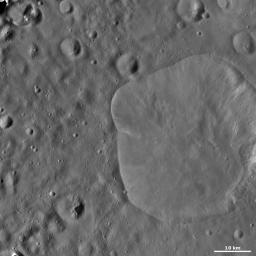This Dawn framing camera (FC) image of Vesta shows Lepida crater. Lepida is the large crater that dominates the right side of the image. Lepida is 44 kilometers (27 miles) in diameter on average and has an irregularly shaped, fresh rim. A smaller crater is barely visible on the left side of Lepida. Part of the edge of this crater forms the lump in Lepida's left side rim. It is possible that other parts of Lepida's irregular rim are formed in a similar manner. The irregular rim may also be caused by slumping or another mechanism. From this image Lepida appears to be a shallow crater, but a cross section of the crater would be necessary to confirm this suggestion. There is some bright material cropping out of Lepida's rim and slumping towards its center, mostly on the right side.
This image is located in Vesta's Floronia quadrangle, in Vesta's northern hemisphere. NASA's Dawn spacecraft obtained this image with its framing camera on Oct. 26, 2011. This image was taken through the camera's clear filter. The distance to the surface of Vesta is 700 kilometers (435 miles) and the image has a resolution of about 68 meters (223 feet) per pixel. This image was acquired during the HAMO (high-altitude mapping orbit) phase of the mission.
The Dawn mission to Vesta and Ceres is managed by NASA's Jet Propulsion Laboratory, a division of the California Institute of Technology in Pasadena, for NASA's Science Mission Directorate, Washington D.C. UCLA is responsible for overall Dawn mission science. The Dawn framing cameras have been developed and built under the leadership of the Max Planck Institute for Solar System Research, Katlenburg-Lindau, Germany, with significant contributions by DLR German Aerospace Center, Institute of Planetary Research, Berlin, and in coordination with the Institute of Computer and Communication Network Engineering, Braunschweig. The Framing Camera project is funded by the Max Planck Society, DLR, and NASA/JPL.
More information about the Dawn mission is online at http://www.nasa.gov/dawn and http://dawn.jpl.nasa.gov.

 Planetary Data System
Planetary Data System












